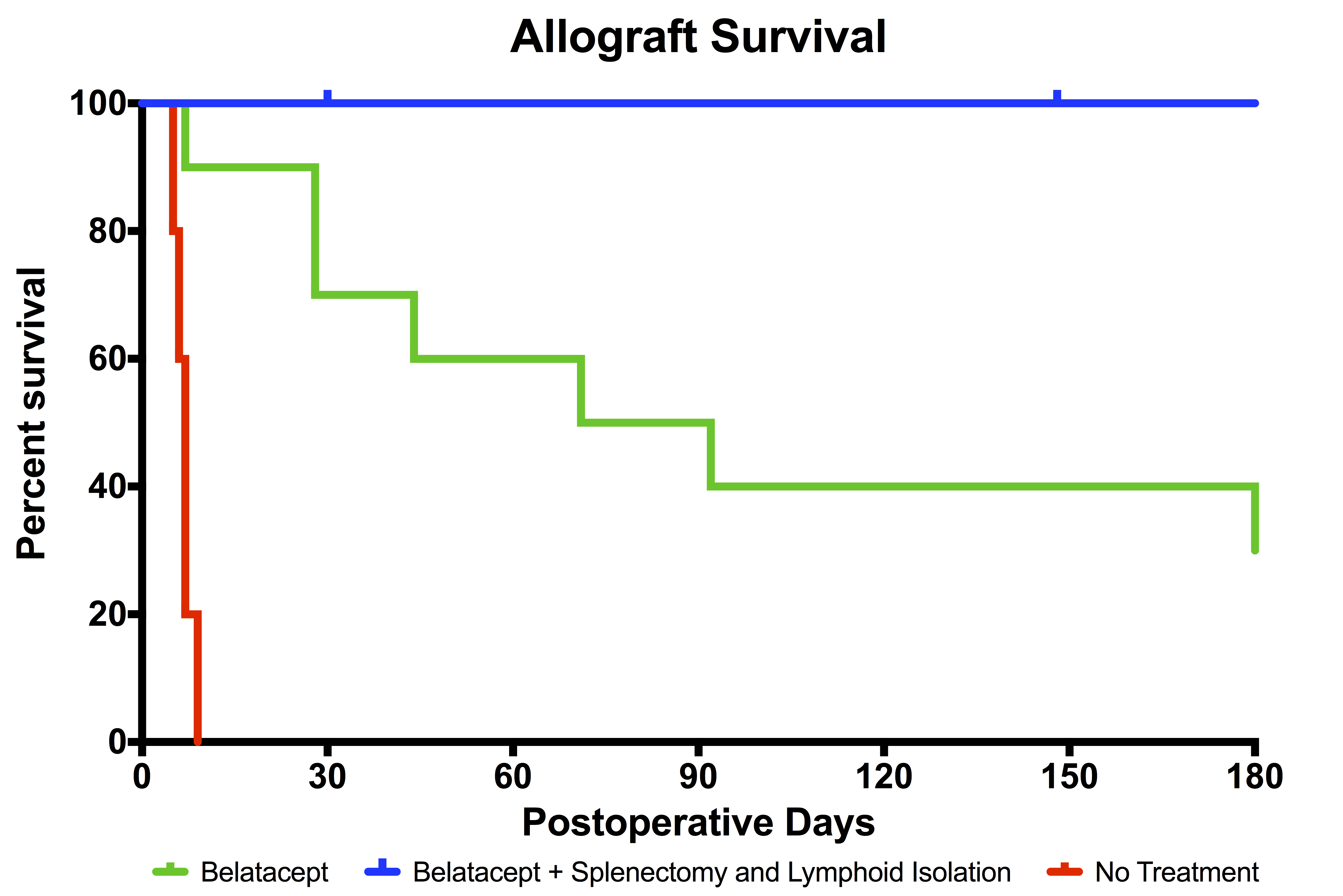Lymphoid Isolation as an Adjuvant Maneuver for Belatacept-Based Immunotherapy.
1Surgery, Duke University Medical Center, Durham, NC
2Surgery, Indianapolis University Medical Center, Indianapolis, IN
Meeting: 2017 American Transplant Congress
Abstract number: B4
Keywords: B cells, Co-stimulation, Kidney transplantation, Primates
Session Information
Session Name: Poster Session B: Acute and Chronic Rejection
Session Type: Poster Session
Date: Sunday, April 30, 2017
Session Time: 6:00pm-7:00pm
 Presentation Time: 6:00pm-7:00pm
Presentation Time: 6:00pm-7:00pm
Location: Hall D1
Purpose: Belatacept targets de novo alloimmune responses with minimal off target effects in renal transplantation, though adjuvant therapy is required for control of costimulation-blockade resistant rejection (CoBRR). Biologics that control lymphoid trafficking mitigate CoBRR. In mouse models, genetic knockouts of secondary lymphoid tissue and those that disrupt lymphoid trafficking permit long term acceptance of vascularized transplants. We tested the hypothesis that anatomically limiting hematogenous and lymphatic egress from a renal allograft by way of splenectomy and surgical lymphoid isolation would prevent CoBRR in a nonhuman primate model of costimulation-blockade based immunotherapy.
Methods: Rhesus macaques (n=14) underwent bilateral nephrectomy followed by MHC mismatched renal allotransplantation. Control transplants (n=10) received a single intraoperative dose of steroid and Belatacept maintenance without anatomic perturbation. Experimental animals (N=4) underwent splenectomy and meticulous ligation of donor lymphatics at recipient operation to control hematogenous and lymphatic egress. Serial creatinine was used to monitor renal function. Longitudinal flow cytometry of peripheral blood mononuclear cells (PBMCs) was performed.
Results: Animals undergoing splenectomy and lymphoid isolation in addition to Belatacept-based immunotherapy had no rejection through 150 days, compared to 60% incidence of CoBRR in controls. Preliminary analysis of longitudinal PBMC phenotyping did not reveal differences in T memory subsets or proliferation. Experimental animals developed increased fractions of naïve B cells (CD27-IgD+), with a concomitant decrease in the fraction of switched and unswitched memory B cells (CD27+IgD+/-), consistent with emerging B cell signatures of tolerance.
Conclusions: Addition of splenectomy and lymphoid isolation decreases rates of CoBRR seen in Belatacept-based immunotherapy. Furthermore, the shift in B cell compartment phenotype is suggestive of a tolerance phenotype recently reported in human renal transplantation. 
CITATION INFORMATION: Mulvihill M, Samy K, Davis R, Leopardi F, Collins B, Kirk A. Lymphoid Isolation as an Adjuvant Maneuver for Belatacept-Based Immunotherapy. Am J Transplant. 2017;17 (suppl 3).
To cite this abstract in AMA style:
Mulvihill M, Samy K, Davis R, Leopardi F, Collins B, Kirk A. Lymphoid Isolation as an Adjuvant Maneuver for Belatacept-Based Immunotherapy. [abstract]. Am J Transplant. 2017; 17 (suppl 3). https://atcmeetingabstracts.com/abstract/lymphoid-isolation-as-an-adjuvant-maneuver-for-belatacept-based-immunotherapy/. Accessed December 15, 2025.« Back to 2017 American Transplant Congress
